McDonald Observatory
 McDonald Observatory showing Mt. Fowlkes (left) and Mt. Locke (right) as seen from the northwest on Texas State Highway 118. | |
| Organization | University of Texas at Austin |
|---|---|
| Observatory code | 711 |
| Named after |
William Johnson McDonald |
| Location | Jeff Davis County, Texas |
| Coordinates | 30°40′17″N 104°01′19″W / 30.6714°N 104.022°WCoordinates: 30°40′17″N 104°01′19″W / 30.6714°N 104.022°W |
| Altitude | 2,070 m (6,790 ft) |
| Established | 1933 |
| Website |
mcdonaldobservatory |
| Telescopes |
Harlan J. Smith Telescope Hobby-Eberly Telescope Otto Struve Telescope |
 Location of McDonald Observatory | |
|
| |
The McDonald Observatory is an astronomical observatory located near the unincorporated community of Fort Davis in Jeff Davis County, Texas, United States. The facility is located on Mount Locke in the Davis Mountains of West Texas, with additional facilities on Mount Fowlkes, approximately 1.3 kilometers (0.81 mi) to the northeast.[1] The observatory is part of the University of Texas at Austin. It is an organized research unit of the College of Natural Sciences.
The observatory produces StarDate, a daily syndicated radio program consisting of short segments related to astronomy that airs on both National Public Radio and commercial radio stations — about 400 affiliates in all.
History

The McDonald Observatory was originally endowed by the Texas banker William Johnson McDonald (1844–1926), who left about $1,000,000 - the bulk of his fortune - to the University of Texas to endow an astronomical observatory. The provision of the will was challenged by McDonald's relatives, but after a long legal fight, the University received about $800,000 from the estate and construction began at Mt. Locke. The then-unnamed Otto Struve Telescope was dedicated on May 5, 1939, and at that time was the second largest telescope in the world. McDonald Observatory was operated under contract by the University of Chicago until the 1960s, when control was transferred to the University of Texas at Austin under the direction of Harlan J. Smith.[2]
Research today at the McDonald Observatory encompasses a wide variety of topics and projects, including planetary systems, stars and stellar spectroscopy, the interstellar medium, extragalactic astronomy, and theoretical astronomy.[3]
Directors[2]
- Otto Struve (1932–1950)
- Gerard Peter Kuiper (Sept. 1947–Dec. 1949, Sept. 1957–Mar. 1959)
- Bengt Georg Daniel Strömgren (Jan. 1951–Aug. 1957)
- William Wilson Morgan (Apr. 1959–Aug. 1963)
- Harlan James Smith (Sept. 1963–1989)
- Frank N. Bash (1989–2003)[4]
- David L. Lambert (2003–2014)[5]
- Taft E. Armandroff (2014–present)[6]
Observatory

The McDonald Observatory is equipped with a wide range of instrumentation for imaging and spectroscopy in the optical and infrared spectra, and operates the first lunar laser ranging station. It works closely with the astronomy department of the University of Texas at Austin while maintaining administrative autonomy. The high and dry peaks of the Davis Mountains make for some of the darkest and clearest night skies in the region and provide excellent conditions for astronomical research.
The Otto Struve Telescope, dedicated in 1939, was the first large telescope built at the observatory.[7][8] It is located on Mt. Locke at an altitude of 2,070 m (6,790 ft). The summit of Mt. Locke, accessed by Spur 78, is the highest point on Texas highways.[9] The Harlan J. Smith Telescope, also on Mt. Locke, was completed in 1968.[10][11]
The Hobby-Eberly Telescope (HET), dedicated in late 1997, is located on the summit of Mt. Fowlkes at 2,030 m (6,660 ft) above sea level.[12] It is operated jointly by the University of Texas at Austin, Pennsylvania State University, Ludwig Maximilians University of Munich, and Georg-August University of Göttingen.[13] As of 2012, the HET is tied with the similar Southern African Large Telescope (SALT) as the fifth largest telescope in the world. However, its cost was about 20% that of other similarly-sized telescopes in use today due to its optimization for spectrography.
Telescopes
Currently, the observatory operates four research telescopes at its West Texas site:
- 9.2 m (360 in) Hobby-Eberly Telescope on Mt. Fowlkes
- 2.7 m (107 in) Harlan J. Smith Telescope on Mt. Locke
- 2.1 m (82 in) Otto Struve Telescope on Mt. Locke
- 0.8 m (30 in) large format imaging telescope on Mt. Locke[14][15]
A 0.9 m (36 in) telescope, formerly used for research, is now used for visitor programs.[16][17]
Tenant telescopes
The two peaks also host a number of other instruments:
- The 1.2 m (47 in) Monitoring Network of Telescopes (MONET) North Telescope on Mt. Locke is a companion to one at the South African Astronomical Observatory in Sutherland, and was built by Halfmann Teleskoptechnik.[18]
- The McDonald Laser Ranging System (MLRS) operates a 0.76 m (30 in) telescope on Mt. Fowlkes to perform satellite laser ranging and lunar laser ranging.[19]
- A 0.5 m (20 in) Ritchey-Chretien reflector owned by Boston University on Mt. Locke is used for optical aeronomy.[20]
- The 0.4 m (16 in) Robotic Optical Transient Search Experiment (ROTSE) reflector on Mt. Fowlkes is used to search for the optical signature of gamma-ray bursts.[21]
Former telescopes
- The 4.9 m (16 ft) Millimeter Wave Observatory (MWO) radio telescope operated on Mt. Locke until 1988.[22] MWO was a joint project between the UT Department of Astronomy and the Department of Electrical Engineering. The site of the dish antenna is now occupied by the BLOOMhouse, the UT School of Architecture's entry in the 2007 Solar Decathlon, which is now used for staff housing.[23]
Climate
The observatory experiences a semi-arid climate (Köppen BSk) with cool, dry winters and hot, dry summers.
- Coordinates: 30°42′19″N 104°01′24″W / 30.70528°N 104.02333°W
- Elevation: 6,790 feet (2,070 m)[24]
| Climate data for Mount Locke, Texas (Jan 1, 1935–Mar 31, 2013) | |||||||||||||
|---|---|---|---|---|---|---|---|---|---|---|---|---|---|
| Month | Jan | Feb | Mar | Apr | May | Jun | Jul | Aug | Sep | Oct | Nov | Dec | Year |
| Record high °F (°C) | 80 (27) |
79 (26) |
88 (31) |
94 (34) |
96 (36) |
104 (40) |
100 (38) |
104 (40) |
96 (36) |
94 (34) |
82 (28) |
80 (27) |
104 (40) |
| Average high °F (°C) | 53.5 (11.9) |
56.9 (13.8) |
63.7 (17.6) |
71.4 (21.9) |
78.6 (25.9) |
84.5 (29.2) |
82.7 (28.2) |
81.3 (27.4) |
76.6 (24.8) |
70.5 (21.4) |
61.2 (16.2) |
54.4 (12.4) |
69.6 (20.9) |
| Daily mean °F (°C) | 42.7 (5.9) |
45.4 (7.4) |
51.0 (10.6) |
58.3 (14.6) |
65.5 (18.6) |
71.4 (21.9) |
70.8 (21.6) |
69.8 (21) |
65.5 (18.6) |
59.3 (15.2) |
50.0 (10) |
44.0 (6.7) |
57.8 (14.3) |
| Average low °F (°C) | 32.0 (0) |
33.9 (1.1) |
38.2 (3.4) |
45.2 (7.3) |
52.4 (11.3) |
58.2 (14.6) |
58.9 (14.9) |
58.4 (14.7) |
54.4 (12.4) |
48.0 (8.9) |
38.7 (3.7) |
33.6 (0.9) |
46.0 (7.8) |
| Record low °F (°C) | −10 (−23) |
−6 (−21) |
4 (−16) |
11 (−12) |
26 (−3) |
36 (2) |
40 (4) |
40 (4) |
29 (−2) |
13 (−11) |
8 (−13) |
−2 (−19) |
−10 (−23) |
| Average precipitation inches (mm) | 0.68 (17.3) |
0.49 (12.4) |
0.40 (10.2) |
0.50 (12.7) |
1.63 (41.4) |
2.49 (63.2) |
3.83 (97.3) |
3.69 (93.7) |
2.95 (74.9) |
1.61 (40.9) |
0.61 (15.5) |
0.60 (15.2) |
19.46 (494.3) |
| Average snowfall inches (cm) | 1.9 (4.8) |
0.8 (2) |
0.2 (0.5) |
0.1 (0.3) |
0.0 (0) |
0.0 (0) |
0.0 (0) |
0.0 (0) |
0.0 (0) |
0.1 (0.3) |
0.4 (1) |
1.2 (3) |
4.7 (11.9) |
| Average precipitation days (≥ 0.001) | 3.75 | 3.13 | 2.62 | 2.77 | 5.93 | 8.75 | 12.00 | 11.56 | 9.32 | 5.91 | 2.94 | 3.29 | 71.45 |
| Source: Western Regional Climate Center, Desert Research Institute[25] | |||||||||||||
Visiting

The Frank N. Bash Visitors Center, located between Mt. Locke and Mt. Fowlkes, includes a café, gift shop, and interactive exhibit hall. The Visitors Center conducts daily live solar viewings in a large theater and tours of the observatory's largest telescopes. It also hosts evening star parties, every Tuesday, Friday, and Saturday evening which allow visitors to look through numerous telescopes of various sizes in the Telescope Park, including the wheelchair accessible Wren Marcario Accessible Telescope (a Pfund Telescope), and enjoy an indoor program.[26]
Special viewing nights, during which visitors can stay on-site (not required for the programs) and view directly through eyepieces on the 0.9 m, Struve (2.1m), or Smith (2.7m) telescopes, are held on a reservation-only basis. Although not available for several years, as of June 2013, the 2.1m has returned to occasional public access.[27]
Gallery
- Entrance to the observatory
- Frank N. Bash Visitors Center
- McDonald Observatory's Visitor Center's Sun Dial
- Harlan J. Smith Telescope preparing for observations
 Texas Historical Marker
Texas Historical Marker Texas Highway Marker at McDonald Observatory
Texas Highway Marker at McDonald Observatory
See also
References
- ↑ "About | McDonald Observatory". McDonald Observatory. Retrieved 2012-01-10.
- 1 2 Evans, David S., University of Texas at Austin McDonald Observatory, Texas State Historical Association
- ↑ "UT Astronomy - Research". University of Texas at Austin Astronomy Program. Retrieved 2012-01-10.
- ↑ McDonald Observatory Visitors Center Named for Former Director Dr. Frank N. Bash, The University of Texas McDonald Observatory, 2006-07-17
- ↑ American Astronomical Society Confers Highest Honor on McDonald Observatory Director David Lambert, The University of Texas McDonald Observatory, 2007-02-05
- ↑ Leading Astronomer Taft Armandroff Appointed New Director of McDonald Observatory, The University of Texas McDonald Observatory, 2014-01-14
- ↑ "McDonald Observatory - 2.1-m Telescope". University of Texas at Austin Astronomy Program. Retrieved 2012-01-10.
- ↑ "The Otto Struve Telescope | What Are Astronomers Doing? | McDonald Observatory". McDonald Observatory. Retrieved 2012-01-10.
- ↑ Dindinger, Peter. (25 August 2009). "The Highest Point on Texas Highways". Retrieved 2012-01-10.
- ↑ "McDonald Observatory - 2.7 m Telescope". University of Texas at Austin Astronomy Program. Retrieved 2012-01-10.
- ↑ "The Harlan J. Smith Telescope | What Are Astronomers Doing? | McDonald Observatory". McDonald Observatory. Retrieved 2012-01-10.
- ↑ "Hobby-Eberly Telescope". University of Texas at Austin Astronomy Program. Retrieved 2012-01-10.
- ↑ "The Hobby-Eberly Telescope | What Are Astronomers Doing? | McDonald Observatory". McDonald Observatory. Retrieved 2012-01-10.
- ↑ "UT Astronomy - 0.8 m Telescope". University of Texas at Austin Astronomy Program. Retrieved 2012-01-10.
- ↑ "0.8-meter Telescope | What Are Astronomers Doing? | McDonald Observatory". McDonald Observatory. Retrieved 2012-01-10.
- ↑ "UT Astronomy - 0.9 m Telescope". University of Texas at Austin Astronomy Program. Retrieved 2012-01-10.
- ↑ "0.9-meter telescope | What Are Astronomers Doing? | McDonald Observatory". McDonald Observatory. Retrieved 2012-01-10.
- ↑ "Welcome to MONET / Astronomie & Internet". University of Göttingen.
- ↑ "McDonald Observatory - Laser Ranging System". University of Texas at Austin Astronomy Program. Retrieved 2012-01-10.
- ↑ "BU Imaging Science - The Boston University 20-inch Telescope at McDonald Observatory". Boston University Center For Space Physics. Retrieved 2012-01-10.
- ↑ "ROTSE Home Page". Robotic Optical Transient Search Experiment. Retrieved 2012-01-10.
- ↑ "University of Texas at Austin, Department of Astronomy, Austin, Texas 78712-1083, McDonald Observatory, Fort Davis, Texas 79734. Report for the period 1 Sep 1988 - 31 Aug 1989". Bulletin of the Astronomical Society. 22: 620. 1990. Bibcode:1990BAAS...22R.620.
- ↑ Johnson, Rebecca (2008-05-01). "McDonald Observatory gets Solar BLOOMhouse « Know". Retrieved 2012-01-30.
- ↑ "US COOP Station Map". Western Regional Climate Center, Desert Research Institute. Retrieved May 3, 2015.
- ↑ "MOUNT LOCKE, TEXAS (416104), Period of Record Monthly Climate Summary". Western Regional Climate Center, Desert Research Institute. Retrieved May 3, 2015.
- ↑ "McDonald Observatory | Public Programs, Star Parties, Tours and Special Viewing Night". McDonald Observatory. Retrieved 2012-01-10.
- ↑ "McDonald Observatory | Public Programs: Special Viewing Night". McDonald Observatory. Retrieved 2012-01-10.
External links
| Wikimedia Commons has media related to McDonald Observatory. |
- McDonald Observatory public site
- McDonald Observatory at the University of Texas at Austin
- StarDate Online and Universo Online
- McDonald Observatory Clear Sky Chart Forecasts of observing conditions.
